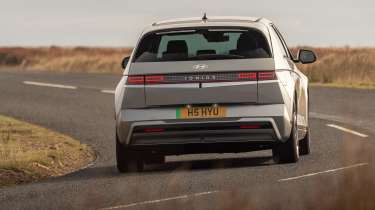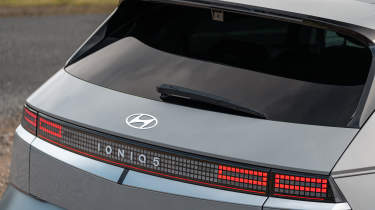Hyundai Ioniq 5 2025 review – Korea’s Volkswagen ID.4 rival means business
The Ioniq 5 might now have some strong competition in 2025, but it’s still among the best in its class as a practical, well-rounded electric crossover
The Hyundai Ioniq 5 has been around for a fair few years now, and while the market has since been flooded with endless alternatives, the 5 is still as strong an option as ever. A recent facelift made sure it stayed up-to-speed with its closest rivals, but if we’re very honest, it never fell far behind. Its blocky ‘80s Delta Integrale-esque design stands up almost half a decade on, and its stats are still a match for the very best in its class.
Its underpinnings are shared with the popular Kia EV6, one of the most impressive ‘ordinary’ EVs we’ve driven, but in the Ioniq 5 are offered in a more diverse range of options with two different battery packs, and both single or dual-motor configurations. In 2025, buyers have the option of either a 63kWh battery pack combined with a single RWD motor option, or a larger 84kWh battery pack in rear or all-wheel drive.
> Hyundai Ioniq 5 N review – the most engaging EV yet
While it might look roughly the size of a Volkswagen Golf-sized hatchback, the Ioniq 5 is more akin to a midsize SUV at 4635mm in overall length, with 3000mm of that being in the wheelbase – that’s 88mm longer than a last-gen Range Rover for reference, and it feels it. The result is more interior space than you’d ever expect, though, something Hyundai’s interior designers have only exaggerated with the flat floor and almost open-plan layout of the seating.
Interior and tech
As bold as its exterior design might be, the interior doesn’t have quite the same flair. The sense of space makes it an excellent tool day-to-day for those with the means to run an EV in such a way (that sliding centre console is genius), but it does lack the character of some rivals. The rounded corners of everything from the dash to the steering wheel give it a dated aesthetic, with the flat, featureless door cards uninspiring – it’s form over function.
More reviews
There are some nice touches, though, with the pixel design motif not limited to the front and rear light bars, but also found within the charging port and even as LED indicators on the steering wheel – this is functional too, as it provides some indication of charging status, gear selection and more. The gear selector stalk itself might be slightly odd to some, being column-mounted, but the use of a premium cold-touch metal makes up for this – even the (physical) steering wheel buttons use the same material and feel reassuringly solid to operate.
A nicely integrated dedicated wireless charging tray, numerous USB Type-C ports and even a fully fledged three-pin plug socket are great to have too, with Vehicle to Load even allowing you to supply external devices with up to 3.2kw of power. It’s features like this that make it feel like a product developed with real-world customers in mind, even if expressive interior design wasn’t at the forefront.
Powertrain and technical highlights
At the bottom of the range lies the 63kWh RWD variant, producing 168bhp and with a quoted 273-mile WLTP range. While the relatively low £39,910 entry price of this model will be enticing for some, it’s not our pick of the bunch, with a lack of power and range outweighing the cost benefit.
Step up to £43,410 and the larger 84kWh battery pack is within reach, bringing a more powerful 225bhp RWD model into the equation for more poke and the best range of the three models at 354 miles. The same battery pack is also available in all-wheel drive, applying a motor to both axles for a 321bhp output – as you’d expect though, range does take a hit at 311 miles.
Efficiency, charging and running costs
Regardless of the powertrain you choose, each and every variant runs on a high-tech, high-efficiency 800V electrical system, just like the Porsche Taycan – it’s also clever enough to switch over to a 400V system when it needs to. The byproduct of this is not only improved efficiency and range, but also quicker charging speeds, with all three models able to charge at up to 260kw at compatible charging stations – one of its closest rivals, the Volkswagen ID.4, manages just 185kw at its best.
We saw 3.1mi/kWh consumption on a mixed run with a combination of careful eco driving, less efficient dual carriageways and tight B-roads. Regardless of driving style, though, the Ioniq 5’s range prediction proved to be one of the most accurate I’ve seen to date, which goes a long way to reducing any range anxiety you might have.
Performance and 0-62 time
The 601bhp Ioniq 5 N is where you’ll find the real performance, but the middling 225bhp we tested provides more than enough performance for everyday drives. Throttle, brake and regen calibration is some of the best I’ve experienced in an EV, with response excellent and power easy to modulate – Eco mode slackens things off considerably, but knock it up a mode and it’s peppy enough to make good progress even in this middling model.
The entry-level 63kWh 168bhp model is the least powerful of the three powertrains, and hits 62mph from a standstill in a quoted 8.5sec. The 225bhp 84kWh RWD model we tested is said to do the same in 7.5sec, with the AWD range-topper managing it in 5.3sec – top speed for all three stands at 114mph flat-out. Every option here is quite some way behind the blistering Ioniq 5 N (capable of a 3.4sec 0-62mph time), but the car we tested has more than enough power for the task at hand.
The inclusion of true one pedal driving contributes to the Ioniq 5’s efficiency, with the tactile wheel-mounted paddles allowing you to adjust regen on the fly. Opt for the most aggressive mode (one pedal driving, or iPedal in Hyundai speak) and it’ll even take distance from the leading car into consideration. This might sound invasive, and it can be in other cars that attempt to achieve the same, but excellent calibration makes it easy to acclimatise to – jump off the throttle and it doesn’t launch you through the windscreen like some systems, but instead slows you gradually in a reasonable manner. On the rare occasion you hit the brake pedal, this too is easy to modulate, with the blend of regen and friction well judged.
Ride and handling
The Ioniq 5’s handling doesn’t quite match the powertrain in terms of sophistication, as while ride is initially well cushioned, the dampers struggle to keep the wheels under full control on trickier surfaces. It’s not a deal-breaker, but where the Kia EV6 is impressive in this regard, the Ioniq 5 falls slightly behind. This isn’t something you’ll encounter on the vast majority of roads, though, with overall ride and refinement strong when the tarmac is in good condition – even at motorway speeds the cabin is supremely quiet and refined, with longer distances easily covered in comfort.
Steering is very light and free of feel, but the rack is quick enough to make mid-corner adjustments easy. The 255-profile front and rear Michelin Pilot Sport EV tyres on our test car provide plenty of grip should you decide to push on, but you will find that the steering doesn’t quite load up in the way you’d like when driven in this way – the slow spring rate and non-adjustable dampers also hold it back, but then this is what the 5 N is for.
Prices and buying options
The Ioniq 5 is available with two battery capacities and with either single or dual motors, the latter specific to just the larger battery pack. Entry-level cars with a single rear-mounted motor and a 63kWh battery pack start at £39,910, putting it directly in-line with the Volkswagen ID.4 and its relative, the Kia EV6.
Opt for the large 84kWh battery pack and prices start from £43,410 in Advance trim, with N-Line trim and above (from £47,410) taking the 63kWh powertrain off the menu entirely. The range-topping N-Line S trim gives you the most standard kit of them all, but retains the option of the lesser (and more efficient) RWD 84kWh powertrain should the £55,910 AWD car not be for you.
Rivals
In terms of rivals, the Kia EV6 is an excellent sub-£50k EV, but the Ioniq 5’s unique design and interior finish make it an attractive alternative. The VW ID.4 has plenty of gaps in its repertoire, while the Skoda Enyaq takes those underpinnings and dresses them in a much nicer suit. However, both are uninspiring to drive. Tesla’s Model 3 Long Range is another alternative that’s an excellent EV, but has the usual Tesla bugbear of questionable build quality.





